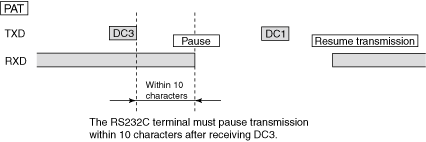Setup
Interface Setup
RS232C (Standard Equipped)
When the PAT-T is shipped from the factory, the RS232C connector has a cover. Keep the cover so that you can attach it to the RS232C connector when the connector is not in use. For safety, always attach the cover to the RS232C connector when the connector is not being used. If the cover is damaged or lost, contact your Kikusui agent or distributor.
RS232C connection
Turn off the POWER switch on the PAT-T and the computer.
Use a D-sub 9-pin female-to-female for the RS232C cable. Figure shows the connector pin assignments.
The PAT-T does not use hardware handshaking (Cross cable example2).

9-pin connector
RS232C configuration
1. If an option board is installed, select RS232C in the CONFIG settings (CF54: 232C).
The switch LED illuminates. The ammeter displays the parameter number, and the voltmeter displays the present setting.
2. In the CONFIG settings, set the RS232C data rate (CF40), RS232C data length (CF41), RS232C stop bit (CF42), and RS232C flow control (CF43).
For the settings, see table of protcol.
Protocol
Table shows the RS232C protocol.
Underline indicates factory default condition.
| Item | Setting |
|---|---|
| Connector | 9-pin D-sub terminal on the rear panel |
Baudrate (CF40) |
1 200 bps/ 2 400 bps/ 4 800 bps/ 9 600 bps/ 19 200 bps/ 38 400 bps (1.2/ 2.4/ 4.8/ 9.6/ 19.2/ 38.4) |
| Data (CF41) | (8 bits/ 7 bits) |
| Stop (CF42) | (1 bit/ 2 bits) |
| Parity | Fixed to none |
| Flow (X-flow control) (CF43) | XFLOW/ None (on/off) |
RS232C communication
Use flow control for RS232C communication. DC (device control) codes are used as control codes.
Transmission/reception may not work correctly through unilateral transmission.
| Code | Functiom | ASCII code |
|---|---|---|
| DC1 (Xon) | Request to send | 11H |
| DC3 (Xoff) | Transmission stop request | 13H |

Break signal
The break signal functions as a substitute for the IEEE488.1 dcl / sdc (Device Clear, Selected Device Clear) message.
